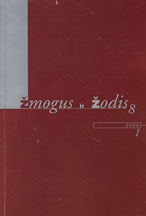Beletristikos tekstų daiktavardžių ir būdvardžių kirčiuočių dažnumas
Frequency of Stressed Nouns and Adjectives within Fiction Texts
Author(s): Vida ŽilinskienėSubject(s): Language and Literature Studies
Published by: Vytauto Didžiojo Universitetas
Keywords: frequency dictionary; nouns; adjectives; stress paradigm; frequency.
Summary/Abstract: The aim of this study is to establish, which stressed nouns and adjectives are most frequent in fiction texts. It may help to understand, which stressed words should be given more attention in the learning/ teaching and speaking process in order to avoid the most characteristic stress misuse that disrupts the system of a Standard language. On the basis of the frequency dictionary of fiction style, the frequency of stress paradigms of nouns and adjectives used in fiction texts is being discussed. The texts have been chosen at random from Lithuanian fiction works published in 1980-1995: novels, tales, stories, short stories and memoirs. The subject of investigation is the correlations of stress paradigms of nouns and adjectives within zones of large, medium and small frequency taken from the frequency dictionary of fiction style. The following conclusions have been drawn: 1. The most frequent ones within Lithuanian fiction texts are root stress nouns (52,79%), the majority of which is 2st stress paradigm words. 2. The most frequently used nouns of the lst stress paradigm are usually stressed in the penultimate syllable (55,97 %). The suffixed nouns are not frequent among nouns of the lst stress paradigm (14,53%). The most frequently used nouns of the 2st stress paradigm more often have a rising accent in the penultimate syllable (69,33 %), suffixed ones comprise 18,54 % (the most frequent are derivatives with the suffix -elis, -ė). 3. There are few nouns of the 3st stress paradigm within fiction texts. This stress paradigm comprises amore significant part only among intensive frequency nouns. 4. The ratio of frequently, less frequently and rarely used stressed adjectives within investigated texts varies greatly. Among frequently used adjectives, words stressed at the ending preponderate (85,13 %), especially frequent are adjectives of the 4st stress paradigm (53,68 %). The more rarely adjectives are used, the greater number of root stress words is found. 5. The greatest part of frequently used adjectives of the 4st stress paradigm is comprised by words with the ending -(i)as, -a (78,79 %). Among frequent adjectives of the 3st stress paradigm 3st stress paradigm words predominate (63,81 %).
Journal: Žmogus ir žodis
- Issue Year: 08/2006
- Issue No: 1
- Page Range: 56-64
- Page Count: 9
- Language: Lithuanian

